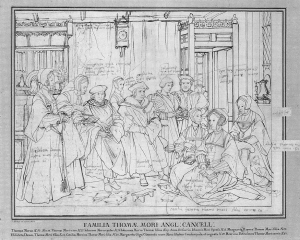The Kirtle: Exploring the Evidence
The Kirtle: Discussion and Evidence
This part of the ensemble is evident in almost every portrait of the period, even those from the Continent. The evidence of the kirtle might only be at the neckline, or the gown might be worn laced and open at the bodice with the kirtle in evidence in the opening. In the late 1530s and 1540s the gown had a split front skirt, and the kirtle, sometimes supporting the 'forepart' is visible in the split.
Bodice/Neckline
In the portraits of the late 1520s to early 1530s the bodice of both the gown and the kirtle seem, as JMD and Co have said, to be 'sprayed on' (Malcolm-Davies et al 2008:22). The neckline is very close fitting, and very wide across the bust. The kirtle, which bears the neckline decoration, rises higher up the bust than the gown, perhaps an inch higher or so. This is evident from early 16th C portraits (see Queen Catherine of Aragon (below) for example), the portrait of Lady Guilford as well as the More family painting and sketch (see below) and many more.
Catherine of Aragon by Lucas Hornebolte (source Wikipedia), early 16th C
To achieve the spray painting look JMD and Co (2008) suggest the the kirtle itself was boned, rather than the woman wearing a corset under the kirtle. They go on in the referenced article to discuss their experiments on boning the gown, or the kirtle, or a corset. A point they make, which I agree with, is that there seems to be no room for the strap of a corset to rise and be hidden under the very wide necklines of the kirtle and gown.
Some of the portraits and paintings, both British and Continental, show the gown open at the bodice, laced across and open down the stomach a bit. In these cases the kirtle shows. In the paintings of the 1520s and early 1530s the kirtle is simply made of a contrasting colored fabric. In later dated paintings (for instance the More family painting which is shown below (a late 1500s copy of the original painting)) the kirtle is a richer fabric, with a pattern.
In the painting and sketch of the More family, the pregnant women wear the gown open, without a front placard, and with the kirtle showing. Their bellies protrude, but their busts are still smooth and the gown and kirtle are still 'spray-painted' on. Is the kirtle in these cases, boned? JMD and Co suggest that the kirtle wasn't heavily boned, light boning gives the profile desired at this point in the development of the Tudor dress. The boning also did not go down the belly very far. There was no long point as in kirtles and gowns of the late 1500s and early to mid 1600s. Perhaps it's possible to wear a kirtle, boned in this earlier style, even when pregnant? I am not a dedicated enough experimental archaeologist to get pregnant in order to decide this question. I am, however, 'full-bodied' (to say the least!). We'll see what my experiences show.
Back
There is basically no pictorial evidence, at least that I've found so far, for the back of the kirtle. The full length sketch to the right possibly shows the edge of the kirtle in the back. Mikhaila and Malcolm-Davies 2006:105-106) conceive of the kirtle back as being square or triangular, with either a trained or regular long skirt. The skirt is gathered, although the front of the skirt is flat (the gathers go around the sides and back). The kirtle can be side or back fastened.
Waist
Mikhaila and Davies (2006) show the kirtle waistline as slightly pointed in the front. I see no reason to disagree with this. The point is very slight, not nearly as deep as that of the later period corsets and gowns.
Closure
The kirtle is probably side or back fastened and I will construct that way.


From Wikipedia. Note the change in personnel between the sketch and the painting.
Sleeves
The kirtle is sleeveless, although it's possible that detachable sleeves could be used if the kirtle were worn without a gown.
References
Malcolm-Davies, Jane, Caroline Johnson and Ninya Mikhaila
2008 ''And her black satin gown must be new-bodied’: The Twenty-First-Century Body in Pursuit of the
Holbein Look' Costume 42:21-29
Mikhaila, Ninya and Jane Malcolm-Davies
2006 The Tudor Tailor BT Batsford London
Sketches and Portraits
If you click on them, you'll be taken to a much larger version, in most cases.
Images from Wikimedia Commons.
Image from the British Museum Collection




